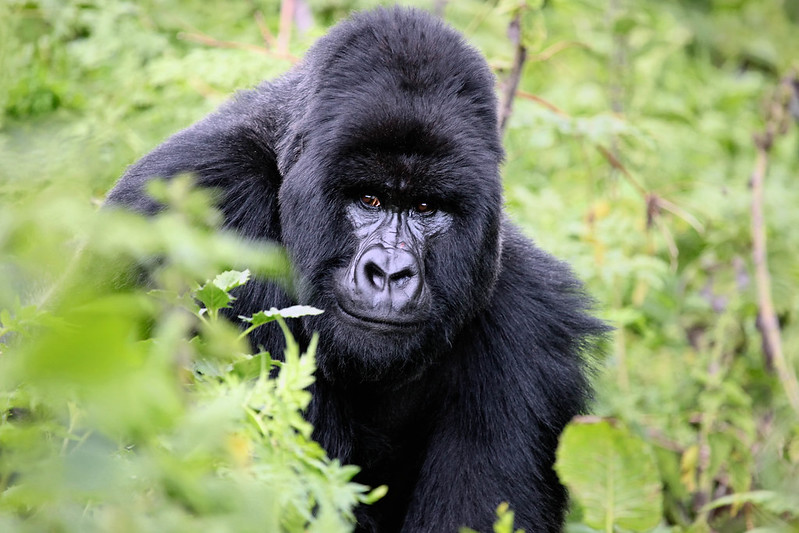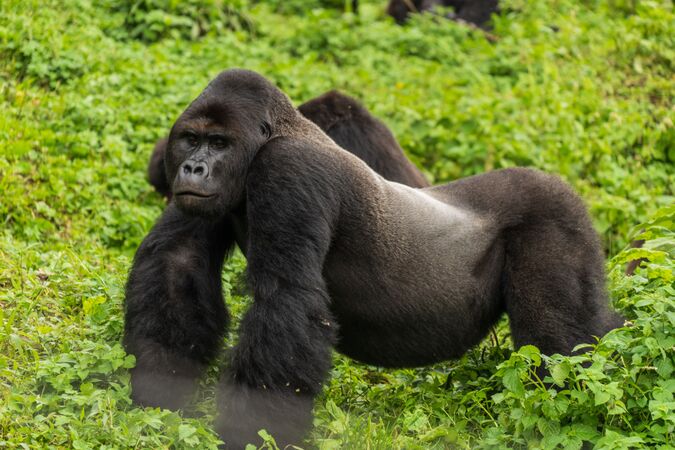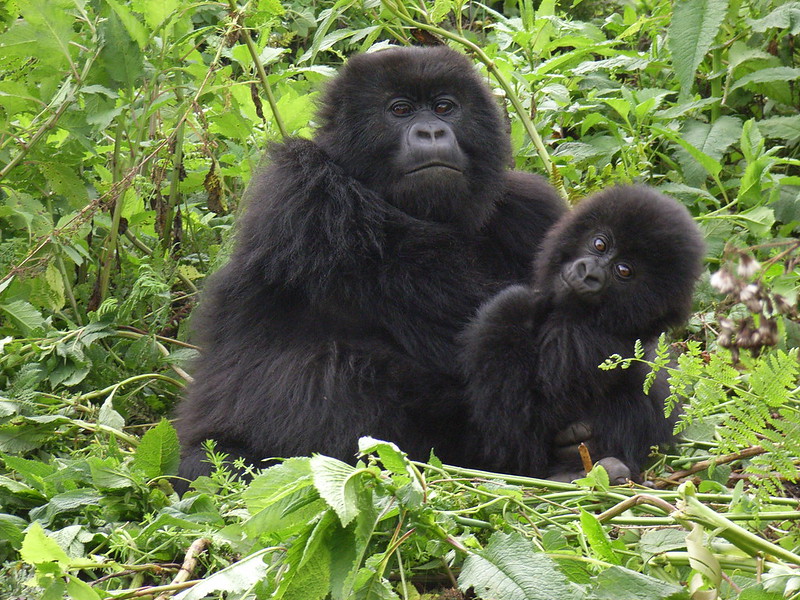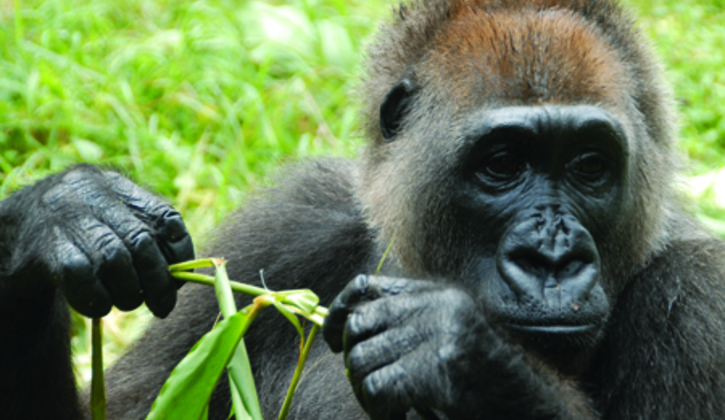Species and Subspecies of Gorillas (types of gorillas )
Species and Subspecies of Gorillas , Gorillas constitute one of the five principal species of giant apes. The remaining four comprise humans, orangutans, chimpanzees, and bonobos. Gorillas are the largest of the great apes and share around 95% of their DNA with humans. They demonstrate compassion, happiness, and despair, and possess the ability to utilize complex tools akin to humans. The prominent gorilla species in Africa The woods of East and Central Africa constitute the sole natural home of gorillas globally. These forests encompass diverse ecosystems, including montane forests, bamboo groves, rainforests, wetlands, marshes, and mountainous regions.
Historically, a single species of gorilla inhabited a singular, expansive tropical rainforest. Over time, the woods became fragmented due to both natural forces and the population growth in Africa. This solitary species of gorilla has spread and adapted to various settings and forest patches. They modified many features, behaviors, and physical structures. Notwithstanding their distinctions, it is very challenging to differentiate one gorilla subspecies from another without prior experience in careful observation.
Comprehensive Overview of All Gorilla Species
Gorillas are substantial primates, with adult males (Silverbacks) over 150 kilos and females approximately 120 kg. Their upper limbs are larger and longer than the lower limbs. Gorillas traverse using all four limbs but adopt a bipedal stance when foraging for food at elevated locations. Gorillas possess wide chests, black or brownish eyes, and prominent noses. The majority of the body is covered with fur, with the exceptions of the face, chest, and tips of the digits. The hair on the dorsal region of mature males becomes grey, which is the reason they are referred to as Silverbacks.

The typical lifespan of a gorilla in the wild is 35 years, however in captivity it is 45 years. Gorillas are very social creatures, forming families or groups that comprise 10 to 30 members. The family consists of a dominant silverback, additional silverbacks, two or three females, juveniles, and newborns. The dominant silverback leads the family and dictates all group activities. The stability of a gorilla family primarily relies on the relationship between the dominant male and the mature females. Silverback gorillas are predominantly polygamous, with all mating initiated by females reaching fertility.
Gorilla Species Inbreeding is infrequent in gorilla families. Young female gorillas typically integrate into other groups or seek a solitary male gorilla upon attaining sexual maturity. Adult males often depart the group upon expulsion by the alpha male silverback, however this is not universally applicable. They will reside alone in proximity to their own family or alongside other young silverbacks. When solitary, the young silverback attempts to abduct females from a rival group. Female gorillas attain sexual maturity at the age of 10, whilst males reach this stage at 15 years.
Gorillas are herbivorous creatures that consume tree shoots, leaves, vines, and branches. They will sometimes consume tiny invertebrates for protein. Gorillas predominantly engage in foraging and nest construction on the ground. Adult gorillas are proficient climbers; nonetheless, they typically eschew trees due to their substantial weight. The younger individuals prefer to spend more time climbing trees. Gorillas have migratory behavior. They continually relocate in search of sustenance or to evade other groups.
It is noteworthy that gorillas, frequently mischaracterized as ferocious creatures, are possibly the most tranquil of primates. They are timid beings and exhibit aggression (charge) just when they perceive a threat of some kind.
Species of Gorillas
Gorilla Subspecies Two species of gorillas inhabit the untamed jungles of Africa. The species encompasses the Eastern gorilla and the Western gorilla. Gorillas are categorized based on their geographical distribution. Western gorillas inhabit the western region of Africa’s tropical rainforest, whilst Eastern gorillas are in the eastern area. As previously noted, gorilla species exhibit modest physical distinctions. Eastern gorillas are marginally larger than Western gorillas. The Eastern Gorillas have denser fur enveloping their bodies. Consequently, the population of Western gorillas in the wilds of Africa exceeds that of Eastern gorillas. Western Gorillas are the species commonly found in zoos and sanctuaries beyond Africa.
There are two Gorilla species, each subdivided into two subspecies. Western gorillas are categorized into Western Lowland gorillas and Cross River gorillas. The Eastern Gorilla is categorized as Eastern lowland gorillas (Grauer’s gorillas) and Mountain gorillas. We may now examine the different gorilla subspecies in greater detail:
Grauer’s Gorilla, or Eastern Lowland Gorilla
(G. beringei graueri), is a subspecies of the Eastern Gorilla. They inhabit the eastern region of the Democratic Republic of Congo. They can be observed at Kahuzi Biega National Park, Maiko National Park, Itombwe Massif, and Odzala-Kokoua National Park. The Eastern Lowland Gorilla is the largest extant primate in the world. Despite being more numerous than Mountain Gorillas, their population has experienced a worse fall in recent years. A century ago, there were more than 20,000 inhabitants, but now just approximately 7,500 individuals remain. The optimal locations to observe these colossal giants are Kahuzi Biega and Maiko National Parks in the Democratic Republic of Congo.

Mountain Gorillas
Gorillas (G. beringei beringei) are arguably the most recognized subspecies of gorillas within the conservation community. They are members of the Eastern Gorilla species and inhabit the Virunga Ranges and Bwindi Forest. Mountain gorillas often inhabit high-altitude regions ranging from 8,000 to 12,000 feet. Mountain gorillas possess more fur than other gorilla subspecies to maintain warmth in their frigid habitats.
The population of mountain gorillas is increasing, with more than 1,000 individuals documented in the wild. This increase is ascribed to their residence in comparatively secure and accessible national parks. Mountain gorillas draw more tourists than any other gorilla subspecies, hence garnering increased conservation efforts and funding. Notwithstanding increased tourism and conservation money, they remain the second most critically endangered of the four subspecies. The optimal locations to observe mountain gorillas are the national parks of Bwindi and Mgahinga in Uganda. Thirty percent reside in Volcanoes National Park in Rwanda, while twenty percent inhabit Virunga National Park in the Congo.

Western Lowland Gorillas (G. gorilla gorilla):
More than 350,000 Western lowland gorillas remain in their natural habitat. They inhabit the lowland tropical rainforests of Central and West Africa, including Nigeria, Cameroon, Equatorial Guinea, Gabon, the Democratic Republic of Congo, Angola, and the Central African Republic. The Western Lowland gorilla is a subspecies of the Western Gorilla species. They are the smallest subspecies of gorillas and possess reduced body fur. Their fur exhibits a greyish-reddish hue.
Western Lowland Gorillas are the species commonly observed in many zoos and sanctuaries beyond Africa. They may also be observed in their natural habitat by visiting several national parks in West and Central Africa. Despite being the most populous, Western lowland gorillas are also classified as endangered, similar to other gorilla subspecies. Their total population has dropped more than that of any other subspecies. In the past thirty years, nearly 60% of the Western Lowland Gorilla population has been diminished owing to habitat destruction, poaching, and the emergence of epidemic diseases such as Ebola.
Cross River Gorillas (Gorilla gorilla diehli):
The Cross River Gorilla is a subspecies of the Western Gorilla. They are larger than their nearest relatives, the western lowland gorilla. Their classification occurred more recently (2000) due to the longstanding belief that the Western gorilla constituted a single species. Cross-river gorillas are dispersed in small groups throughout the lowland montane forests of Cameroon and Nigeria, encompassing an area of 3,000 square miles. They represent the most critically endangered subspecies of gorillas, with an estimated natural population of approximately 300 individuals. This diminished figure is attributable to their proximity to human settlements. Their numbers have been severely diminished because of habitat destruction, hunting, and human-induced diseases.

Cross River gorillas exhibit increased aggression due to their regular interactions with humans. They endure significant persecution and ongoing conflicts with humans over territory. This has compelled the authorities in Cameroon and Nigeria to designate some regions as habitats for the Cross River gorilla. The two governments collaborate closely with international animal conservation agencies to prevent the extinction of the Cross River gorilla.
It is important to note that Cross River Gorillas are absent from zoos, and following them is unfeasible. The sole method to observe them is by visiting sanctuaries in Nigeria and Cameroon.
Supplementary Information – Endangered Classification, Conservation Efforts, and Gorilla Tourism
Gorillas are classified as endangered and are listed on the International Union for Conservation of Nature (IUCN) Red List. Their total population has significantly diminished over the last two centuries due to habitat degradation, hunting, and illnesses. Human encroachment, logging, and other activities have resulted in habitat loss in tropical rainforests. Poaching and the profitable pet and bush meat trade, particularly in West and Central Africa, have significantly contributed to the collapse of gorilla populations. In addition to poaching, gorillas have also been unintentionally killed by snares intended for other forest creatures. The Ebola outbreak in West and Central Africa resulted in numerous gorilla fatalities.
Despite being an endangered species, we are pleased to announce that the overall population of gorillas is now increasing. The increase is ascribed to the significant endeavors of animal conservation organizations and the respective governments in the regions inhabited by gorillas. Various techniques have been explored to prevent the extinction of gorillas. International Wildlife Conservation Agencies employ a policy of directly funding initiatives aimed at protecting gorilla subspecies in Africa. They have also commenced initiatives focused on safeguarding the primates and their ecological environment. An illustration of this initiative is the treatment of ailing gorillas in their natural habitat by the Gorilla Doctors and the Dian Fossey Fund International.
Gorilla tourism has significantly contributed to the increase in gorilla numbers. Gorilla trekking is costly; yet, it has drawn prominent tourists who have heightened global awareness of the challenges faced by gorillas and the necessity for their conservation. Regular tourists indirectly support gorilla conservation through the purchase of gorilla trekking permits. The cash generated from permits is allocated for infrastructure development, training Rangers to safeguard gorillas from poachers, and employing local residents near the gorilla parks. Research indicates that communities aware of the advantages of tourism are less inclined to harm wildlife.
Despite significant achievement, Wildlife Conservation Agencies continue to confront challenges including poaching, civil conflicts in gorilla habitats, inadequate conservation legislation, and corruption.
